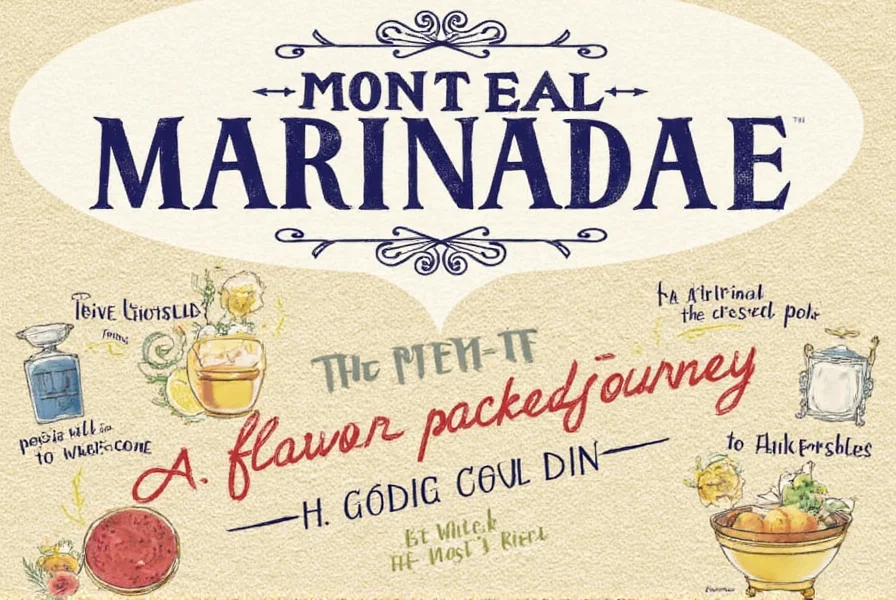Montreal marinade, also known as Montreal steak spice, is a Canadian dry rub spice blend traditionally used for seasoning meats. It's known for its bold, savory, and peppery flavor profile, made from coarse black pepper, garlic, coriander, dill, and mustard seeds.
Understanding the Flavor Profile
| Flavor Component | Description |
|---|---|
| Savory | Dominant notes from garlic and mustard seed |
| Pungent | From fresh coriander and dill seeds |
| Earthy | Thanks to the coarsely ground black pepper |
| Peppery Heat | Not spicy-hot, but sharp and punchy |
This isn't your average salt-and-pepper combo — it's got layers. Perfect for adding depth without overpowering your main ingredient.
DIY Montreal Marinade Recipe
Ingredients
- 2 tbsp coarse black pepper
- 1 tbsp granulated garlic
- 1 tbsp coriander seeds
- 1 tbsp mustard seeds
- 1 tbsp dill seeds
- 1 tsp paprika (optional)
- 1 tsp chili flakes (optional, for heat)

Instructions
- Toast the coriander, mustard, and dill seeds in a dry pan until fragrant.
- Let them cool slightly, then crush with a mortar and pestle or pulse in a grinder.
- Mix with the rest of the ingredients in a bowl.
- Store in an airtight container away from light and heat.
Pro Tip: Double the batch — it keeps well for up to 6 months!
How to Use It Like a Pro
- Rub generously on steak before grilling for that classic Montreal flavor.
- Try it on chicken wings — they'll be crispy, juicy, and full of zesty bite.
- Use it to season pork chops for a robust dinner.
- Even sprinkle on fries or roasted potatoes for a gourmet twist.
- Blend with oil or yogurt to make a quick dipping sauce or dressing.
Buying Guide: Choosing the Best Montreal Marinade
| Brand | Features | Best For | Occasions |
|---|---|---|---|
| Levitt's Original Montreal Steak Spice | Classic blend with no added preservatives, gluten-free | Traditionalists and grill lovers | BBQ parties, backyard cookouts |
| McCormick Montreal Steak Seasoning | Affordable, widely available, mild flavor | Beginners or budget-conscious cooks | Weeknight dinners, casual meals |
| Bush BBQ Montreal Style Rub | Smoky twist, vegan-friendly | Vegetarian and vegan dishes | Vegan burgers, grilled tofu |
| Spiceology Montreal Marinade | Coarse texture, high-quality ingredients | Pro chefs and foodies | Restaurants, gourmet events |
What to Look For
- No artificial fillers or preservatives
- Coarse texture for better adhesion to meat
- Clear labeling of spice origins and sourcing
- Allergen-free if needed (gluten, soy, etc.)

Frequently Asked Questions
What's the difference between Montreal steak spice and Montreal marinade?
Despite the name "marinade," this is actually a dry rub, not a liquid marinade. The terms "Montreal steak spice" and "Montreal marinade" are used interchangeably, though "steak spice" is more accurate since it's applied dry. The confusion comes from marketing, but both refer to the same coarse spice blend.
Can I use Montreal marinade as a dry rub?
Absolutely! In fact, that's how it was originally used — pressed onto raw meat before cooking. The coarse texture creates a flavorful crust when grilled or seared.
Is Montreal marinade spicy?
It's more peppery and pungent than spicy-hot. However, some store-bought versions might add chili flakes for extra heat. The traditional blend relies on black pepper for its "heat" rather than chilies.
Does traditional Montreal marinade contain salt?
Surprisingly, authentic Montreal steak spice typically does NOT contain salt. This allows you to control your sodium levels separately. Many commercial versions, however, do add salt, so check the label if you're watching your sodium intake.
How long does homemade Montreal marinade last?
Properly stored in an airtight container away from light and heat, homemade Montreal marinade will stay fresh for 6-8 months. The dry ingredients maintain their potency longer than wet marinades. For best flavor, make smaller batches you'll use within 3-4 months.
Can Montreal marinade be used on seafood?
Yes! While traditionally used on beef, it works wonderfully on firmer fish like salmon, tuna, and swordfish. For more delicate seafood like shrimp or scallops, use a lighter application as the strong flavors can overpower them.
Is Montreal marinade gluten-free?
The traditional spice blend is naturally gluten-free as it contains only spices and herbs. However, some commercial versions may include anti-caking agents or be processed in facilities with gluten. If you have celiac disease or gluten sensitivity, look for certified gluten-free options.
What can I substitute if I don't have Montreal marinade?
You can try a mix of garlic powder, black pepper, onion powder, coriander, and mustard powder. For smokiness, add a pinch of smoked paprika. The closest substitute would be 2 parts black pepper, 1 part garlic powder, 1 part onion powder, ½ part coriander, and ½ part mustard powder.
How long should I marinate meat with it?
Since it's a dry rub, you don't need to marinate for hours. Just apply generously and let sit for 20-30 minutes before cooking for optimal flavor absorption. For thicker cuts like roasts, you can leave it on for 2-4 hours in the refrigerator.
Can I use Montreal marinade for vegetarian dishes?
Absolutely! It adds great flavor to grilled portobello mushrooms, roasted vegetables, tofu, and even popcorn. Many vegan chefs use it as a seasoning for plant-based burgers and meat alternatives.
Final Thoughts
Whether you're flipping steaks at a summer barbecue or spicing up your weeknight roast chicken, Montreal marinade is a must-have in your spice rack. Its unique combination of boldness and versatility makes it a crowd-pleaser for both professionals and home cooks.
So next time you see that little shaker of steak spice on the shelf, grab it. Or better yet, make your own. Your taste buds will thank you!










 浙公网安备
33010002000092号
浙公网安备
33010002000092号 浙B2-20120091-4
浙B2-20120091-4